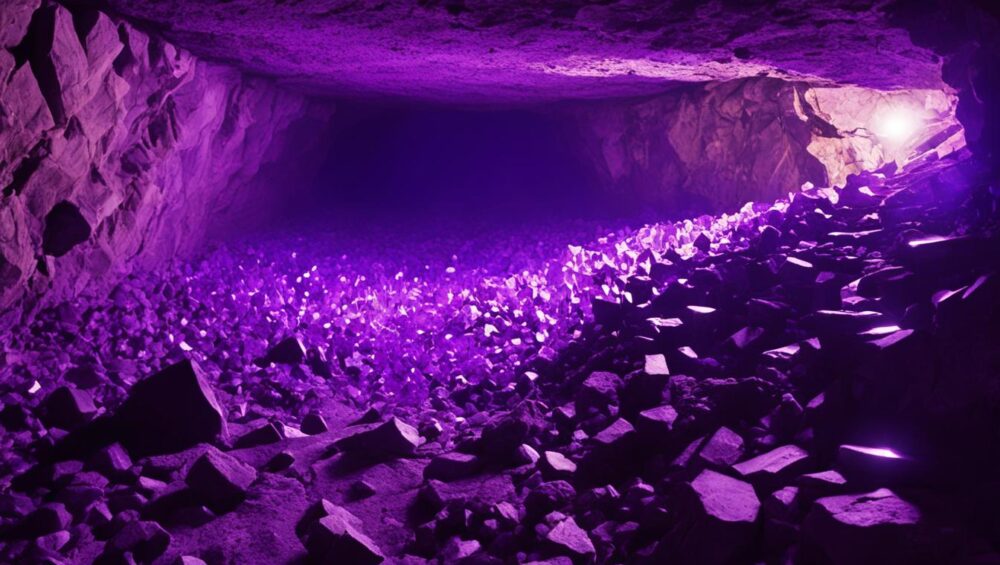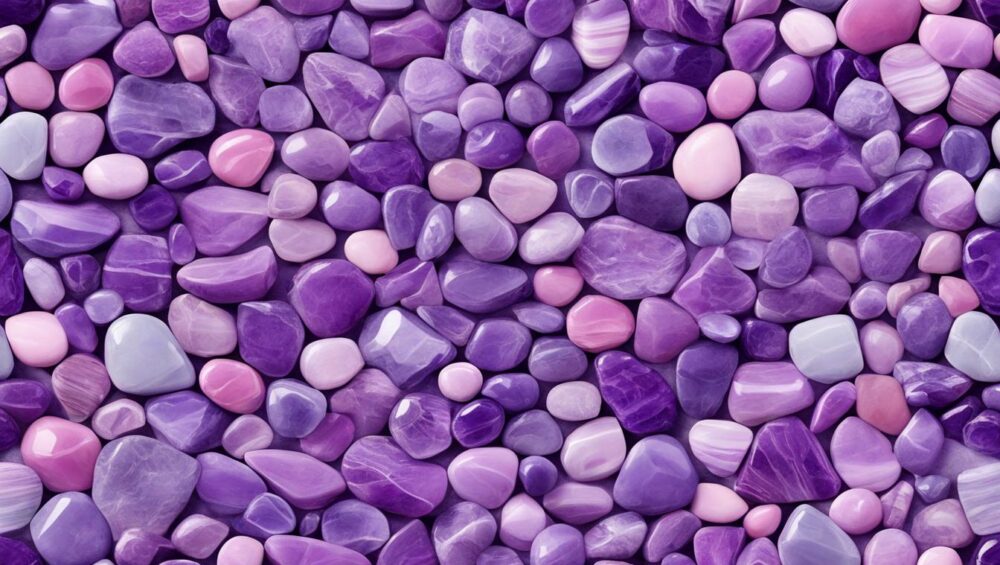Amethyst, a popular purple gemstone, can be found in various locations across the United States. From the amethyst mines in Thunder Bay, Ontario in North America to amethyst mining spots in South America, Africa, and Australia, there are plenty of places to find this beautiful crystal. But if you’re wondering where you can find amethyst in the US specifically, you’re in luck!
In the US, amethyst can be found in states like Arizona, Arkansas, California, Colorado, Georgia, Illinois, Minnesota, Missouri, New York, Nevada, North Carolina, Ohio, Oregon, Pennsylvania, South Carolina, Texas, and Wisconsin. These states are known for their amethyst deposits and provide ample opportunities for gem enthusiasts to explore and discover these gleaming purple treasures.
Whether you’re an experienced rockhound or just getting started, there are various amethyst sources in the US where you can embark on your treasure-hunting journey. And if you’re not up for the adventure, you can also find amethyst for sale through online and physical retailers.
Key Takeaways:
- Amethyst can be found in various locations across the United States including Arizona, Arkansas, California, Colorado, Georgia, Illinois, Minnesota, Missouri, New York, Nevada, North Carolina, Ohio, Oregon, Pennsylvania, South Carolina, Texas, and Wisconsin.
- States like Arizona and South Carolina have renowned amethyst mines known for their unique and high-quality crystals.
- Amethyst is a durable gemstone formed in prismatic crystals within amethyst geodes.
- Amethyst is mostly found in volcanic rocks and is formed through hydrothermal fluids.
- Whether you prefer to hunt for amethyst or purchase it, there are plenty of options available for gem enthusiasts.
What Is Amethyst and Where Is It Formed?
Amethyst, a captivating purple gemstone, is formed in prismatic crystals within amethyst geodes. These geodes are hollow rock cavities lined with inwardly projecting crystals that vary in size and shape. The geodes are typically found in volcanic rocks, formed as a result of solidified hydrothermal fluids that moved away from magma along fissures and fractures.
The formation of amethyst is a fascinating process that involves the combination of natural radiation and minute amounts of ferric iron (Fe3+). This combination contributes to the distinct coloration of amethyst, which can range from delicate shades of pale lilac to deep hues of violet.
While amethyst is commonly found in volcanic rocks, it can also occur in metamorphic rocks, although it is relatively rare in sedimentary rocks. The necessary conditions for amethyst formation, such as the presence of suitable minerals and the right temperature and pressure, are typically found in the cavities of volcanic rocks.
Amethyst’s unique formation process and its association with volcanic activity give it a special allure. Its vibrant color and crystalline structure make it a sought-after gem among collectors, jewelry enthusiasts, and crystal healing practitioners.
Amethyst Geodes: Nature’s Hidden Treasures
Amethyst geodes, also known as amethyst caves, are natural wonders that house the beautiful amethyst crystals within their captivating interiors. These geodes form when gas bubbles in volcanic rocks become filled with mineral-rich groundwater. Over time, as the groundwater evaporates, it leaves behind layers of minerals like quartz and amethyst.
Amethyst geodes come in various sizes, ranging from small geodes that can fit in the palm of your hand to massive geodes that can weigh several tons. The larger geodes often contain clusters of amethyst crystals that create a breathtaking display of vibrant purple hues.
Amethyst geodes are cherished for their beauty and spiritual significance. Many believe that these geodes possess unique energy properties that promote harmony and balance. They are often used as decorative pieces, meditation aids, and as sources of positive energy in living spaces.
| Key Features of Amethyst Geodes: | Benefits and Uses: |
|---|---|
| Prismatic crystals within | Enhances spiritual growth and intuition |
| Natural formation in volcanic rocks | Calming and stress-relieving properties |
| Variety of sizes and color intensities | Beautiful home decor and conversation pieces |
| Captivating displays of vibrant purple hues | Energetic cleansing and purification |
Where Can Amethyst Be Found in the US?
In the United States, there are various amethyst locations and mines where you can go amethyst hunting. Some notable places include Arizona, Arkansas, California, Colorado, Georgia, Illinois, Minnesota, Missouri, New York, Nevada, North Carolina, Ohio, Oregon, Pennsylvania, South Carolina, Texas, and Wisconsin. These states have specific areas or mines where amethyst crystals can be found.
For example, Four Peaks Mine in Arizona is known for its unique and dark-colored Siberian Red Amethyst, while the Diamond Hill Mine in South Carolina is famous for its high-quality amethyst, which is also the state gemstone.
Whether you’re a beginner or an experienced rockhound, there are plenty of options for amethyst hunting in the US.
Conclusion
Amethyst, a beautiful purple gemstone, can be found in various locations across the United States, making it easily accessible to rockhounds and gem enthusiasts. Whether you prefer to explore amethyst mines or hunt for crystals in specific areas, there are numerous options available to satisfy your amethyst desires.
Some of the popular amethyst locations in the US include Thunder Bay in Ontario, Canada, as well as states such as Arizona, California, Georgia, Minnesota, New York, North Carolina, and Texas. These places are known for their abundance of amethyst crystals and attract both beginners and experienced collectors.
If you’re not keen on hunting for amethyst in nature, you’ll be pleased to know that there are also plenty of online and physical retailers where you can buy amethyst gemstones. Whether you’re looking for a stunning piece of jewelry or a unique home decor item, these retailers offer a wide variety of amethyst options to suit your taste and budget. So, whether you choose to hunt or shop, happy journey in finding your perfect purple gemstone!
FAQ
Where can amethyst be found in the US?
Amethyst can be found in various locations across the United States, including states like Arizona, Arkansas, California, Colorado, Georgia, Illinois, Minnesota, Missouri, New York, Nevada, North Carolina, Ohio, Oregon, Pennsylvania, South Carolina, Texas, and Wisconsin.
Are there amethyst mines in the US?
Yes, there are amethyst mines in the US. Some notable places include Four Peaks Mine in Arizona, Diamond Hill Mine in South Carolina, and various locations in states like Arkansas, California, Colorado, Nevada, and Wisconsin.
Where are the best places to find amethyst in the US?
The best places to find amethyst in the US include Thunder Bay in Ontario, Canada, as well as states like Arizona, Arkansas, California, Colorado, Georgia, Illinois, Minnesota, Missouri, New York, Nevada, North Carolina, Ohio, Oregon, Pennsylvania, South Carolina, Texas, and Wisconsin. These locations have specific areas or mines where amethyst crystals can be found.
Where can I go amethyst hunting in the US?
You can go amethyst hunting in various states across the US, such as Arizona, Arkansas, California, Colorado, Georgia, Illinois, Minnesota, Missouri, New York, Nevada, North Carolina, Ohio, Oregon, Pennsylvania, South Carolina, Texas, and Wisconsin. These states have specific areas or mines where you can search for amethyst crystals.
Where can I buy amethyst in the US?
You can buy amethyst in the US from various online and physical retailers. Some popular options include gemstone stores, jewelry stores, and websites specializing in gemstone sales. These retailers offer a wide range of amethyst gemstones for purchase.




